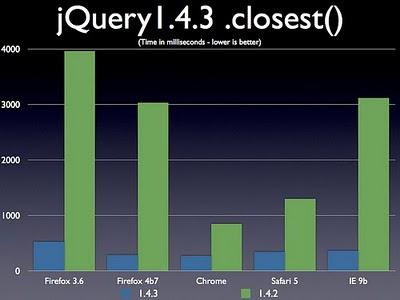HTML5 selectors and jQuery
In my first post on the HTML5 javascript Selector
API
I wondered how the new methods querySelector() and querySelectorAll()
would influence jQuery.
At the time, I couldn’t find any information on the subject, but
yesterday I found out that jQuery has been taking advantage of these new
methods since version 1.4.3.
From the release notes..
The performance of nearly all the major traversal methods has been drastically improved. .closest(), .filter() (and as a result, .is()), and .find() have all been greatly improved.
These improvements were largely the result of making greater use of the browsers querySelectorAll and matchesSelector methods (should they exist). The jQuery project petitioned the browsers to add the new matchesSelector method (writing up a test suite, talking with vendors, and filing bugs) and the whole community gets to reap the excellent performance benefits now.
The above performance results specifically look at three very common cases in jQuery code: Using .closest() on a single DOM node, using .filter() (or .is()) on a single DOM node, and using .find() rooted on a DOM element (e.g. $(“#test”).find(“something”)).Note that the the browsers shown are those that actually support querySelectorAll or matchesSelector – existing browsers that don’t support those methods continue to have the same performance characteristics.
Looks like it’s not a bad idea to keep an eye on the release notes..


